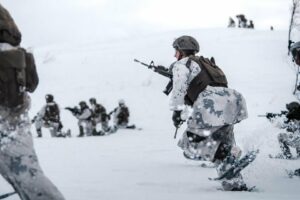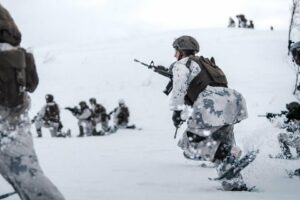
Russia loves energy. It’s the natural resource it values above all others. But it also likes seafood, minerals and territory. The Arctic has all of these things.
The Russian government will soon present a unified document on Arctic development to President Vladimir Putin, meant to combine economic and military aspects of the country’s power projection in the northern region, according to Defense News.
The document, ordered by Putin in early March, is expected to provide an agenda of the Russia’s military and economic plans as the country prepares to preside over the Arctic Council in 2021-2023. The body, which was established in 1996, include members Canada, Denmark, Finland, Iceland, Norway, Russia, Sweden and the United States.
According to a March report (below) by the Stockholm International Peace Research Institute, 80 percent of Russia’s natural gas and 17 percent of its oil production comes from the Arctic. The region as a whole is seen by observers as a future battleground for both military and economic competition between rival powers.
Sipriinsight2103 Arctic Triangle 0 by OWNEditor on Scribd
“This region has traditionally been and remains in the sphere of our special interests. Practically all aspects of national security are concentrated here: military-political, economic, technological, environmental, and resource,” Putin said in 2014 during Russian Security Council meeting on the Arctic region.
That was the same year Russia annexed the Crimean Peninsula from Ukraine. It was also the year the Russian military doctrine for the first time included a line about “protecting Russian interests in the Arctic.”
So we have to ask: Were the US/Norway troop training maneuvers held in March, a readiness exercise?
Apparently, U.S. Marines and sailors with Marine Rotational Force-Europe 21.1 participated in Arctic Littoral Strike in Northern Norway with the Norwegian military in March, the U.S. Marine Corps announced.
The exercise, conducted between March 11 and 31, focused on joint naval integration with Norwegian submarines and reinforced live-fire attacks.
UPI says the Marines received a training mission that required the unit to observe routes that could be used by an adversary in the Arctic fjords, allowing a Norwegian submarine to move without being impeded. But the real interesting thing is that to prepare for this, “the Marines spent weeks participating in cold-weather training led by Norwegian instructors — honing their ability to live, thrive, and fight in the Arctic.“
Also in March, a U.S. B-2 bomber and F-35 fighter planes from Norway’s air force executed a night exercise near the Arctic Circle. And in 2020, Marines from the 3rd Battalion of the 6th Marine Regiment conducted Exercise Reindeer II, a six-week Arctic training exercise that wrapped in early December in Norway.
